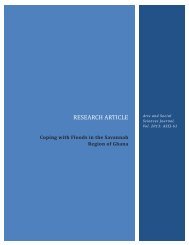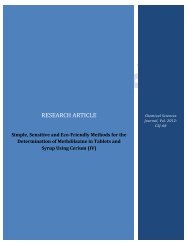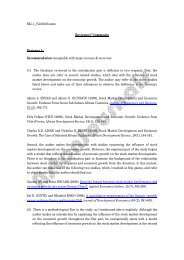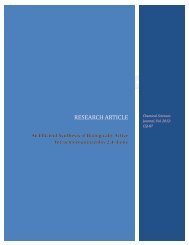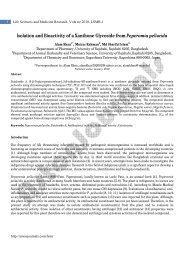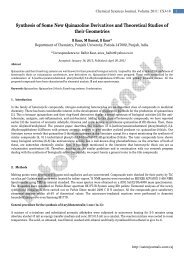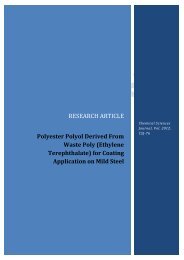Rapid and Sensitive Spectrophotometric ... - AstonJournals
Rapid and Sensitive Spectrophotometric ... - AstonJournals
Rapid and Sensitive Spectrophotometric ... - AstonJournals
Create successful ePaper yourself
Turn your PDF publications into a flip-book with our unique Google optimized e-Paper software.
Chemical Sciences Journal, Vol. 2012: CSJ-80<br />
11<br />
Method<br />
BTB Method<br />
BCG Method<br />
BCP Method<br />
Table 3: Evaluation of intra-day <strong>and</strong> inter-day precision <strong>and</strong> accuracy.<br />
PPL taken<br />
Intra-day (n = 7) Inter-day (n = 5)<br />
(µg ml -1 ) PPL found a<br />
(µg ml -1 )<br />
%RSD b %RE c PPL found a<br />
(µg ml -1 )<br />
%RSD b<br />
%RE c<br />
2.00 1.98 0.77 1.10 2.02 1.41 1.00<br />
4.00 4.07 1.22 1.64 4.07 0.91 1.64<br />
6.00 6.11 1.08 1.83 6.12 0.78 2.03<br />
2.00 2.02 1.66 1.26 2.03 1.54 1.32<br />
4.00 3.98 1.67 0.38 4.02 0.73 0.53<br />
6.00 6.02 1.86 0.38 6.04 1.57 0.70<br />
2.40 2.41 0.54 0.22 2.43 0.86 1.31<br />
4.80 4.80 0.89 0.02 4.82 0.67 0.60<br />
7.20 7.18 0.81 0.28 7.23 1.74 0.37<br />
Mean value of five determinations; b. Relative st<strong>and</strong>ard deviation (%); c. Relative error (%).<br />
a.<br />
Table 4: Robustness <strong>and</strong> ruggedness.<br />
Method<br />
BTB Method<br />
PPL taken,<br />
Method robustness Method ruggedness<br />
µg ml -1 Parameters altered<br />
Reagent volume, ml a<br />
RSD, %<br />
(n = 3)<br />
Reaction time b<br />
RSD, %<br />
(n = 3)<br />
Inter-analysts<br />
RSD, %<br />
(n = 4)<br />
a In all methods, the volume of reagent was 0.8, 1.0 <strong>and</strong> 1.2 mL. b The reaction time was 4, 5 <strong>and</strong> 6 min for method C.<br />
Inter-cuvettes<br />
RSD, %<br />
(n = 4)<br />
2.00 1.06 1.74 1.38<br />
4.00 1.24 1.39 1.32<br />
6.00 0.93 1.18 1.09<br />
BCG Method 2.00 1.31 1.56 1.41<br />
4.00 0.78 1.43 1.30<br />
6.00 1.09 1.55 1.39<br />
BCP Method 2.40 0.91 1.01 1.16 0.99<br />
4.80 1.42 1.29 1.47 1.35<br />
7.20 1.37 1.43 1.29 1.12<br />
3.2.4 Effect of co-formulated substances<br />
The effect of co-formulated substances was tested by placebo blank <strong>and</strong> synthetic mixture analyses. A convenient<br />
aliquot of the placebo blank solution was subjected to analysis according to the recommended procedures. There<br />
was no interference by the inactive ingredients as indicated by the near blank absorbance in all the methods.<br />
The analyses of synthetic mixture solution yielded percent recoveries which ranged between 98.99 –<br />
102.1 <strong>and</strong> with st<strong>and</strong>ard deviation of 0.78 – 1.56. The results of this study indicated that the inactive ingredients<br />
did not interfere in the assay.<br />
3.2.5 Application to analysis of spiked urine sample <strong>and</strong> pharmaceutical formulations<br />
The proposed methods were successfully applied to the determination of PPL in spiked urine sample with mean<br />
percent recovery of 106.4 ± 1.85 (n=5), 108.1±2.12 (n=5) <strong>and</strong> 105.9 ± 0.93 (n=5), for BTB, BCG <strong>and</strong> BCP methods,<br />
respectively <strong>and</strong> the results of two representative tablet <strong>and</strong> capsule were statistically compared with those of the<br />
official method [7] by applying the Students t-test for accuracy <strong>and</strong> F-test for precision (Table 5). The reference<br />
method describes a potentiometric titration of ethanolic solution of PPH with sodium hydroxide. As can be seen<br />
from the Table 5, the calculated t-value <strong>and</strong> F-value at 95% confidence level did not exceed the tabulated values of<br />
http://astonjournals.com/csj



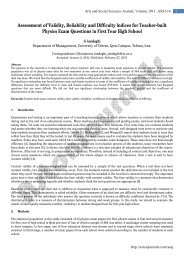
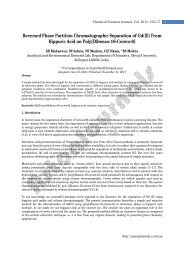
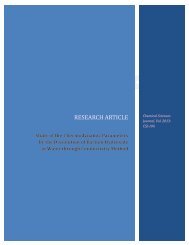
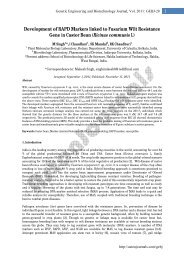
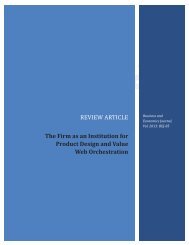
![[1,4]-benzodiazepine-2-one Derivatives as Potent - AstonJournals](https://img.yumpu.com/49117784/1/184x260/14-benzodiazepine-2-one-derivatives-as-potent-astonjournals.jpg?quality=85)
